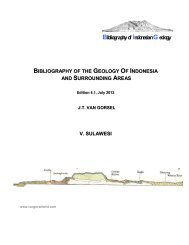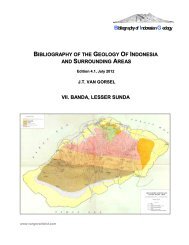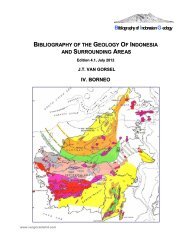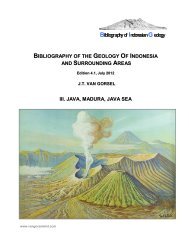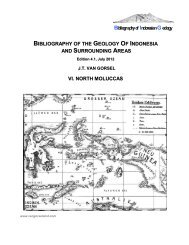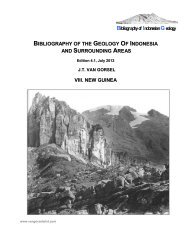Sumatra, Sunda Shelf, Natuna - Bibliography of Indonesia Geology
Sumatra, Sunda Shelf, Natuna - Bibliography of Indonesia Geology
Sumatra, Sunda Shelf, Natuna - Bibliography of Indonesia Geology
Create successful ePaper yourself
Turn your PDF publications into a flip-book with our unique Google optimized e-Paper software.
Mone, A. & S. Samsidi (1993)- A successful gas injection project in the Kakap KF Field: design,<br />
implementation and results. Proc. 22nd Ann. Conv. Indon. Petrol. Assoc. 1, p. 323-340.<br />
Morley, R.J., H.P. Morley & P. Restrepo-Pace (2003)- Unravelling the tectonically controlled stratigraphy <strong>of</strong><br />
the West <strong>Natuna</strong> Basin by means <strong>of</strong> palaeo-derived Mid-Tertiary climate changes. Proc. 29 th Ann. Conv. Indon.<br />
Petrol. Assoc. 1, p. 561- 584.<br />
(15 climate cycles interpreted from Late Eocene- M Miocene. Arang Fm climate cycles reflect mainly very wet<br />
climates, but with cool lowstand phases, and warm climate highstands. Barat, Udang and Gabus cycles<br />
characterized by cool and dry lowstands and warm and slightly wetter highstands. Belut Group cycles trend<br />
from drier to wetter with little temperature change)<br />
Morley, R.J., P. Salvador, M.I. Challis, W.R. Morris & I.R. Adhyaksawan (2007)- Sequence biostratigraphic<br />
evaluation <strong>of</strong> North Belut Field, West <strong>Natuna</strong> Basin. Proc. 31 st Ann. Conv. Indon. Petrol. Assoc. IPA07-G-120,<br />
p. 357-375.<br />
(Stratigraphic model <strong>of</strong> N Belut field reservoir interval from foraminiferal and palynological analysis <strong>of</strong> Barat,<br />
Udang and Gabus Fms. Fourteen bi<strong>of</strong>acies in lacustrine and coastal plain facies. Shales either allocyclic or<br />
autocyclic. 15 cycles, capped by allocyclic shale and interpreted as 4th-order sequences, identified through U<br />
Gabus and Udang Fms. Packages can be differentiated into 3 groups, thought to reflect 3rd-order sequences)<br />
Mujito, S. Hadipandoyo & Suprijanto (1995)- Hydrocarbon assesment <strong>of</strong> the carbonate play, East <strong>Natuna</strong> basin.<br />
In: J. Ringis (ed.) Proc. 31st Sess. Comm. Co ord. Joint Prospecting Min. Res. Asian Offshore Areas (CCOP),<br />
Kuala Lumpur 1994, 2, p. 10-19.<br />
(E <strong>Natuna</strong> basin considered to form W part <strong>of</strong> large Sarawak Basin. N-S trending Oligo-Miocene rift-basin.<br />
Middle-Late Miocene carbonates with local buildups in N half <strong>of</strong> E <strong>Natuna</strong> basin (Terumbu Fm). Risked total<br />
resources in carbonate paly may be as high as 1,196 MT oil and 3,110 Gm3 <strong>of</strong> gas)<br />
Murbini, S. (2000)- Technology challenge for <strong>Natuna</strong> gas development. Proc. 27th Ann. Conv. Indon. Petrol.<br />
Assoc, 2, p. 339-351.<br />
Nagura, H., H. Honda & S. Katori (2000)- Tertiary inversion tectonics and petroleum systems in West <strong>Natuna</strong><br />
Sea Basins, <strong>Indonesia</strong>. J Japanese Assoc. Petrol. Techn. 65, 1, p. 91-102.<br />
(online at: http://www.journalarchive.jst.go.jp/...)<br />
(In Japanese, with English summary. W <strong>Natuna</strong> Sea Basins inverted Tertiary intra-continental rift-basins on<br />
<strong>Sunda</strong> <strong>Shelf</strong>. Basin deposits include M-U Eocene lacustrine, Oligocene fluvial-deltaic, E Miocene muddy facies,<br />
M Miocene sand-dominant deposits, and Late Miocene-Recent mud-sand deposits. No E-M Miocene<br />
carbonates. Four petroleum systems identified: 1A (Belida oil field), 1B (Tembang, Buntal and Bintang Laut<br />
gas pools), 2B (Forel oil pool, Belanak oil and gas field) and 2A (Udang oil field))<br />
Nugraha, R.S., R. Wijayanti & H. Mohede (2012)- Geological concept to geomodel: lessons learned from the<br />
Belanak Field Arang-3 development. Proc. 36th Ann. Conv. Indon. Petrol. Assoc., Jakarta, IPA12-G-182, p. 1-<br />
13.<br />
(Reservoir model <strong>of</strong> Late to M Miocene Arang-3 secondary gas reservoir in Belanak oil-gas field in Block B,<br />
<strong>Natuna</strong> Sea. Interpreted as NNE-SSW trending lower delta plain distributary channel complex)<br />
Pangarso, B., J. Guttormsen, P. Schmitz, I. Sihombing & H. Eko (2010)- North Belut Field- complex clastic<br />
diagenesis in an inverted paleo-structure. Proc. 34 th Ann. Conv. Indon. Petrol. Assoc. IPA10-G-184, 16 p.<br />
(W <strong>Natuna</strong> Basin Belut 1974 discovery undeveloped until 2009. Structure originally paleo-tilted fault block,<br />
which flooded, filled, then inverted. Hydrocarbon zones in Udang and Gabus Fms fluvial- deltaic clastics. Crest<br />
<strong>of</strong> structure good porosity- permeability sands; downdip portions <strong>of</strong> field tight due to ferroan cement)<br />
Phillips, S., L. Little, E. Michael & V. Odell (1997)- Sequence stratigraphy <strong>of</strong> Tertiary petroleum systems in the<br />
West <strong>Natuna</strong> Basin, <strong>Indonesia</strong>. In: J.V.C. Howes & R.A. Noble (eds.) Proc. Petroleum Systems <strong>of</strong> SE Asia and<br />
Australasia Conf., Indon. Petrol. Assoc., Jakarta, p. 381-389.<br />
<strong>Bibliography</strong> <strong>of</strong> <strong>Indonesia</strong> <strong>Geology</strong> v. 4.1 149 www.vangorselslist.com July 2012



